
Leonardo's Sculpture
What did Leonardo da Vinci do as a sculptor?
Leonardo da Vinci preferred painting as the highest form of art, but he also worked as a sculptor. Unlike other sculptors such as Michelangelo, however, Leonardo did not want to carve blocks of marble with a hammer and chisel because he found it a dirty and noisy activity. Instead, Leonardo preferred the cleaner but technically more demanding bronze casting process.
Which of Leonardo's sculptures are known?
Leonardo twice tried to create a monumental equestrian statue. It was supposed to be the largest bronze statue in the world at that time. However, due to political upheavals, high material costs and the lengthy process of creating such a work of art, he only succeeded once in making at least the plaster model of the horse needed for the bronze casting. The plaster model, completed in 1494 for Duke Ludovico Sforza of Milan, was almost seven meters high and was publicly exhibited in Milan. Before it could be cast in bronze, it was destroyed in 1499 when the French occupied Milan. In 1999, 500 years after the destruction of the plaster model, two modern reconstructions of the equestrian statue in its original size were created based on Leonardo's surviving sketches. The "Cavallo Leonardo" (Ital. 'Leonardo's Horse') is located in Milan, Italy. The "American Horse" was erected in Grand Rapids (Michigan, USA). However, both reproductions lack the additional planned rider. Another equestrian statue planned by Leonardo was the Trivulzio Monument (from 1508), but it did not make it past the design stage. In addition, art historians suspect early works by Leonardo in some terracotta figures, which are said to have been created during his training with Andrea del Verrocchio. However, the attribution is very controversial, so that only the two planned equestrian statues can be regarded as sculptural projects by Leonardo.
What is the Paragone?
The "Paragone delle Arti" (Ital. 'contest of the arts') is a term from art theory. It is about answering the question of which art form is the most perfect. This scholarly discussion began in antiquity and continued in the Renaissance. Leonardo da Vinci spent a lot of effort in his writings arguing in favour of painting. Other artists, such as Michelangelo, argued for sculpture. Since this contest cannot be won without disparaging the other art forms, a legendary feud is said to have developed between Leonardo and the younger Michelangelo.
Poor is the disciple who does not surpass his master.
Education at Verrocchio
Leonardo da Vinci became a pupil of Andrea del Verrocchio's workshop in Florence at the age of about 12. Verroccio, like all artists of the time, was not committed to any one style of art. He worked mainly as a sculptor and painter, although his main focus was on sculpture. Verrocchio's preferred technique was bronze casting. The young Leonardo is said to have been the model for one of his bronze statues. Marble statues by Verrocchio have also been preserved.
Bronze casting has been known since antiquity, but it is technically very complex. Because of this and the high cost of materials, bronze sculptures are very expensive. At that time, the commercial metropolis of Florence was considered one of the richest cities in the world. Therefore, enough patrons were found and bronze statues came back into fashion. Besides Verrocchio, the Florentine artist Donatello was famous for his bronze figures.

The first life-size male nude since antiquity was commissioned by the Florentine Medici banking family

Verrocchio was Leonardo's teacher. The 14-year-old Leonardo is said to have posed for the David. Here, too, the commission came from the Medici family.

The bust resembles in hairstyle and clothing a painting attributed to Leonardo, the Portrait of Ginevra de' Benci (c. 1474-78)
Early works by Leonardo
The Bust of Christ
Leonardo regularly made lists of his possessions in his notebooks. It is therefore known that Leonardo owned a small bust showing the head of Christ. It is unclear whether he made the bust himself. A bust made of terracotta, now privately owned (Rome), is associated with this note. Some art historians claim that it was created by Leonardo. Unfortunately, only a few poor quality photographs of it exist. However, the artistic quality casts considerable doubt on the fact that Leonardo created the bust.
The Angel of San Gennaro
In a church in San Gennaro there is a statue that has only been regarded as the work of the Verrocchio workshop since the 1960s. Some art historians believe that Leonardo da Vinci may have made it. San Gennaro is relatively close to Pistoia (about 25km), which in turn is quite close to Florence (about 30km).
In 1477, Verrocchio was commissioned to make an altarpiece in Pistoia in memory of Donato de' Medici, the former bishop of Pistoia. The altarpiece was created by Verrocchio's pupil Lorenzo di Credi. It is considered certain that Leonardo was in Pistoia in 1478 (Leonardo's dated note), presumably to assist his fellow pupil Lorenzo in the conception of the altarpiece. Leonardo's aunt Violante also lived there, whom he may have visited on that occasion.
Some art historians are of the opinion that Leonardo could have made the terracotta statue in San Gennaro. The fact that it was made of terracotta, i.e. fired clay, and is therefore very fragile, speaks against this. Although Verrocchio's workshop often worked with terracotta and Leonardo himself claims to have mastered this form of sculpture, he always tried to produce his works of art in such a way that they could be preserved for as long as possible. In addition, the statue is first mentioned in the archives of the church of San Gennaro in 1773, when it broke during work and had to be reassembled. It could therefore also be a later work that was merely created in the manner of Leonardo's aesthetics.

The angel resembles the depictions of angels in paintings attributed to Leonardo. It is therefore assumed that Leonardo produced the figure. In principle, the origin of the angel cannot be proven
The equestrian monument to Ludovico Sforza
Francesco Sforza (1401-1466) became the first high noble from the House of Sforza when he received the Duchy of Milan. His son Ludovico Sforza (1452-1508), Duke of Milan and Leonardo's employer during his time in Milan (1482-1499), wanted to erect a huge bronze equestrian statue in his honour in Milan. The statue was to be over seven metres high. The design, construction of the casting model and the casting itself had never been carried out in this dimension before. The project was a great technical challenge for the sculptors of the time. Public tenders had been held since the 1470s, but no one had yet been found who wanted to take on the commission.
Contemporary equestrian statues
The equestrian statue of the Sforzas was to become the largest of its time. Equestrian statues had been prestigious works of art since antiquity. In particular, the surviving equestrian statue of the ancient Roman Emperor Marcus Aurelius (121-180 AD) is still considered one of the most important of its kind. The artists of the Renaissance saw themselves in competition with the works of antiquity. With the increasing self-confidence of the Italian city-states in the 14th and 15th centuries and the ever-improving skills of their artists, the desire grew to express this self-confidence through monumental works of art and to surpass those of antiquity. On the one hand, the statues were to represent the power of the city states, and on the other hand, their beauty was to be a symbol of the artistry of their artists.

The approx. 4m high statue of the "philosopher-emperor" is one of the most famous works of fine art and served as a model for numerous equestrian statues.

The approx. 3m high equestrian statue of the famous Donatello is regarded as the beginning of a new era of monumental equestrian statues made of bronze
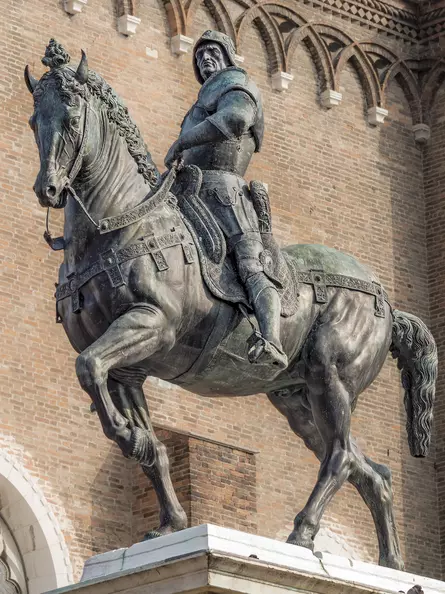
Leonardo's teacher did not live to see the completion of this work, which is about 4 meters high. He died in Venice in 1488 while waiting for the bronze for the final casting. For his monumental last masterpiece he had left Florence two years earlier
Leonardo's enthusiasm for horses
At the time of the Renaissance, horses were ubiquitous in the cities. They served as beasts of burden and transport. Beautiful horses in particular were considered status symbols. Leonardo owned his own horses at the latest when he founded his own workshop around 1478. He admired them above all for their ability to feed only on grass and yet develop tremendous muscular strength. This greatly impressed the vegetarian Leonardo.
The young artist Leonardo was certainly aware that one day his wealthy clients would expect him to depict a representative horse. He therefore had a good knowledge of their anatomy. He had dissected several horses, and his notebooks show that he also made investigations into the proportions of their limbs, much as he had done with the Vitruvian man.



Leonardo's application for the project
eonardo da Vinci applied for the position of court engineer and court artist at the court of Milan in 1482 with his famous letter to Ludovico Sforza. In it, he recommended himself almost casually and only at the end of the letter for the realisation of an equestrian statue.
"I also deal with sculptures in marble, in bronze and in earth [terracotta]; likewise I make paintings, anything you want. I would also be able to work on a statue of an equestrian in bronze, which is to be erected for immortal glory and eternal honour, thus also for the happy memory of Your Glory Father and the princely House of Sforza."
The doubts of the Duke
The plans for the statue became more and more concrete and the Duke commissioned Leonardo around 1488. He began to have doubts about Leonardo's qualifications shortly afterwards, however, and in July 1489 he had a secret letter drawn up for Lorenzo de' Medici, Leonardo's former patron in Florence.
"[...] Mr Ludovico wants to prepare a worthy tomb for his father and in the meantime has commissioned Leonardo da Vinci to make a model. It is an oversized bronze horse on which Duke Francesco sits in full armour. And since His Serene Highness the Duke wishes to execute a thing of the highest order, he has instructed me to write to you on his behalf that he wishes you to send one or two masters who would be suitable for this work. And although His Serene Highness has already given the commission to Leonardo da Vinci, it does not seem to me that he is particularly recommended for the execution [...]".
Implementation of the project
But no one else was found for the project, at least Leonardo kept the commission. Due to its enormous height of 7m, the statue posed a challenge simply because of the supporting structure. Leonardo produced several designs. A first version with a rearing horse was discarded because of the difficult balancing. Presumably this change to the design was the moment when Ludovico Sforza began to have doubts about Leonardo's suitability for the project.
A second version then showed only a trotting horse, which was easier to realise. Typical of Leonardo, this version nevertheless shows a challenging peculiarity. The horse does not stand on three legs, as in contemporary models, but only on two. This increases the realism of the representation enormously and gives the sculpture a more dynamic appearance, but also makes it more difficult to balance the sculpture so that it does not topple over. This, and the size of the statue, show that Leonardo wanted to create something unprecedented.
Leonardo subsequently drew up concrete plans for carrying out the bronze casting process. Finally, in 1494, a preparatory full-size plaster model was made and put on public display. The 7m plaster model was absolutely necessary for the casting. Numerous YouTube documentations show the individual steps of the complex bronze casting process using modern examples.







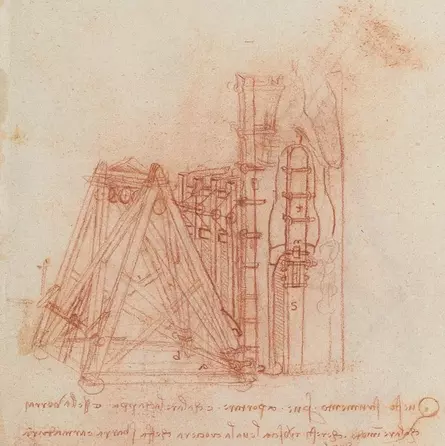
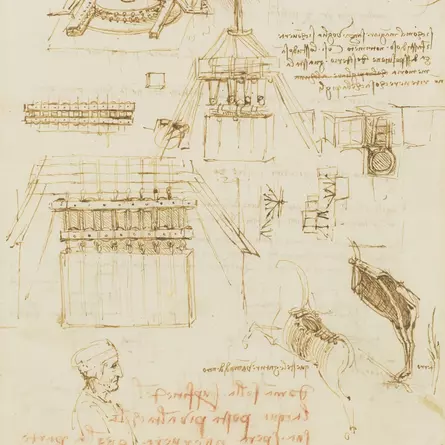

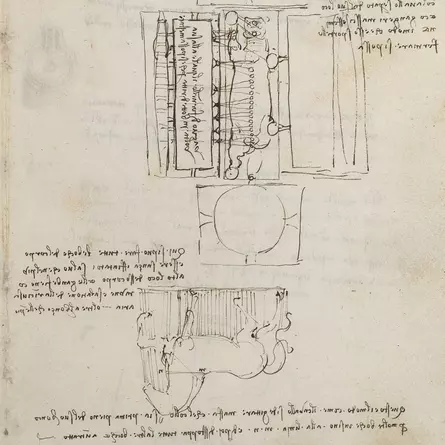

Destruction of the plaster model and replicas
For the final realisation of the huge sculpture, the enormous amount of 70 tons of bronze was brought in, which was, however, briefly misappropriated for the construction of cannons in 1495. The Duke of Milan needed weapons for a war with the French. After brief successes, the duke lost the war with France and was driven out of Milan by the French invasion in 1499.
The existing plaster model was completely destroyed after the conquest of Milan in 1499 by French soldiers. On the basis of Leonardo's drawings, an attempt was made to reconstruct the statue he had planned. This has resulted in two modern replicas. One called "American Horse" in the USA and another called "Cavallo Leonardo" in Milan. Both were reconstructed to scale and, like the original plaster model, are about 7m high. It goes without saying that these models cannot correspond exactly to Leonardo's design, especially as both models lack the rider - i.e. Franceso Sforza - but they can nevertheless give an idea of the monumental size of the project today.
If the equestrian statue had been erected in the centre of Milan as originally intended, the enormous bronze horse in honour of Il Moro (The Black One), as Ludovico Sforza was also called, would certainly have borne witness to its imposing nature even today.
The Milanese replica called "Cavallo Leonardo" is today located in the San Siro district, a few metres away from Milan's football stadium at the horse racing track, the "Hippodrome de San Siro".

This modern replica is based on drawings from Leonardo's notebooks. Like the original, it is 7m high. The horse was originally supposed to carry a rider, but Leonardo did not leave any precise drawings of this
Background: The number of hooves in the air
It is often mentioned that the position of a horse's hooves in equestrian statues symbolizes the circumstances of the rider's death.
- Four hooves on the ground are said to indicate a natural cause of death.
- One raised hoof is thought to imply a death in motion (such as during a journey or a campaign).
- Two raised hooves of a rearing horse are believed to suggest a death in battle.
However, there is no fixed rule stating that the position of the hooves always reflects the rider's cause of death. The contemporary equestrian statues shown above all have one raised hoof, yet only Marcus Aurelius actually died while on a journey, while the other two died of natural causes.
Therefore, it is more plausible to explain the position of the hooves as stemming from both artistic intention and the technical skills of the artist. A horse standing with all four hooves on the ground exudes calmness and dignity but can also appear uneventful. It is also easy to maintain balance and less prone to tipping over. Similarly, a horse that lifts only one hoof appears to be in motion but still stands firmly on the other three legs.
Leonardo da Vinci, on the other hand, aimed not only to create the largest equestrian statue in the world at that time but also one in which the horse stood on two legs. The fact that the depicted Francesco I. Sforza died in his sickbed and not in battle suggests that the choice of representation was motivated by artistic expression. Leonardo likely discarded an initial rearing version, perhaps due to technical challenges, and opted for a trotting horse with two raised hooves. In other words, the approximately seven-meter-tall equestrian statue would have stood on the two legs of the horse, along with the rider. Since Leonardo had already completed the plaster model for casting, he must have succeeded in balancing the statue to prevent it from tipping over. The four-meter-tall equestrian statue of Bartolomeo Colleoni shown above, completed around the same time by Leonardo's teacher Andrea del Verrocchio, has only one raised hoof. In this sense, Leonardo's Sforza statue was likely also intended to showcase his mastery of bronze casting.
The Trivulzio Monument
After the Milanese Duke Ludovico Sforza was expelled from Milan in 1499, Leonardo also left the city and subsequently stayed mainly in his home town of Florence. As he had good connections to the French royal court, he was offered the opportunity to work in Milan again around 1506, only this time for the French governor. Leonardo subsequently commuted between Florence and Milan. From 1508, Leonardo stayed mainly in Milan. Among his new tasks was the realisation of a monument to the victorious French general Gian Giacomo Trivulzio, who conquered the Duchy of Milan. Trivulzio came from an old Milanese noble family, but had fallen out with Ludovico Sforza and entered French service as a mercenary. For the conquest of Milan he was appointed Marshal of France.
It is not without a certain irony that Trivulzio's monument hardly progressed beyond the design phase. For Massimiliano Sforza, a son of the former Duke of Milan, was able to regain the Duchy of Milan in 1512 with the help of Swiss mercenaries. The idea of a monument to Trivulzio was now overtaken by events. In 1513 Leonardo left Milan for good and followed the Pope's call to Rome. Leonardo did not work on another equestrian statue until his death in 1519.








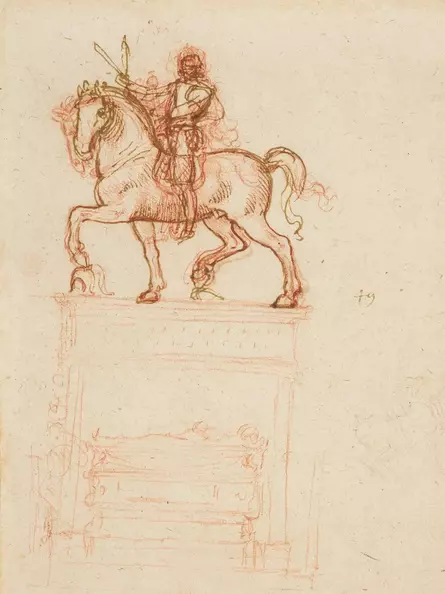
Paragone - Contest of the Arts
The debate over which is the highest form of art is known as "Paragone." This is a centuries-old dispute among scholars that dates back to ancient times. Leonardo always regarded painting as the highest form of art and actively participated in the Paragone through various writings.
This was not merely an intellectual debate; it also encompassed the question of societal recognition of painting as a free art form, with all the privileges associated with it for painters. These privileges included demands for their own guilds, tax exemptions, and even the right to bear noble titles. The dispute unfolded through written arguments and public discussions, often involving intense rhetorical confrontations between artists of different genres.
Leonardo's Comparison of Painting and Sculpture
Sculpture
"When the sculptor works on his piece, he removes marble and other stone by the exertion of arm and hammer, which cover the figure enclosed inside in excess, which is a thoroughly mechanical activity and often involves a great deal of sweat and dust, which mix together to form mud. With his face covered all over with marble dust, he looks as if it has snowed on his back, and his house is dirty, full of stone chips and dust."
Painting
"Quite the opposite of the painter (I am speaking here exclusively of excellent painters and sculptors), because the painter sits comfortably and well-dressed in front of his work, wielding the lightest brush with delightful colours. His clothes follow his taste and his house, adorned with charming paintings, remains clean, often accompanied by music or varied, pleasant readings, which he follows joyfully without loud hammering and other noise."

Leonardo and Michelangelo
Presumably, the Paragone is also the reason behind Leonardo's falling-out with the renowned sculptor and painter Michelangelo. This is because Michelangelo gave preference to sculpture and argued in its favor. A legendary feud is said to have existed between Leonardo and Michelangelo. The early biographer of Leonardo, Vasari, wrote in 1550:
"Between Leonardo and Michelangelo, there was a great aversion, and the competition between the two was the cause of Michelangelo leaving Florence, being excused by Duke Giuliano, as he had been summoned by the Pope for the façade of San Lorenzo. When Leonardo heard this, he also left and went to France, where the King owned several works by him and was very fond of him."
Michelangelo's Comment on the Sforza Horse
An unnamed biographer (Codex Magliabechiano, around 1540) reports Michelangelo's comment on the Sforza Horse:
"And as Lionardo and Giouanni da Gauine from Santa Trinità passed by the Spini Bank, where a gathering of good men was held, and where a passage from Dante was being discussed, they called to Leonardo and told him he should explain this passage to them. And when Michelangelo happened to pass by and was called upon by one of them, Leonardo replied, 'Michelangelo will proclaim it himself.' Michelangelo thought he said this to mock him and answered angrily, 'You should be able to explain it too, for you have made a drawing of a model to cast it in bronze and could not cast it, and out of shame left it alone.' And after saying this, he cut short their words and left, upon which Leonardo remained behind, blushing due to the words spoken."
The duke lost power, his possessions and freedom. And no work for him was completed.
Sources
Frank Zöllner, Leonardo, Taschen (2019)
Martin Kemp, Leonardo, C.H. Beck (2008)
Charles Niccholl, Leonardo da Vinci: Die Biographie, Fischer (2019)
Frank Zöllner/ Johannes Nathan, Leonardo da Vinci - Sämtliche Zeichnungen, Taschen (2019)
Highly recommended
Marianne Schneider, Das große Leonardo Buch – Sein Leben und Werk in Zeugnissen, Selbstzeugnissen und Dokumenten, Schirmer/ Mosel (2019)
Leonardo da Vinci, Schriften zur Malerei und sämtliche Gemälde, Schirmer/ Mosel (2011)
![[Translate to english:] [Translate to english:]](/fileadmin/_processed_/8/b/csm_leonardo-alle-gemaelde_2dc4b01ef6.webp.pagespeed.ce.ohfmgl8OfF.webp)
![[Translate to english:] [Translate to english:]](/fileadmin/_processed_/d/f/csm_raffael-schule-von-athen_5726e8e83c.webp.pagespeed.ce.EMhUyGJ50I.webp)

